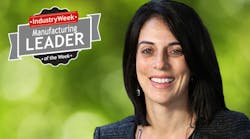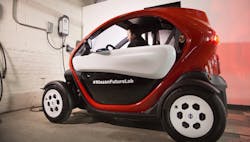If a golf cart and an electric scooter had a baby—and then that baby got a paint job in Willy Wonka’s candy factory—you might have something that approximates the Scoot Quad, Nissan’s experimental mobility vehicle currently tooling around San Francisco streets at 25 mph. The vehicle is part of a partnership between ride-sharing startup Scoot and Nissan’s Future Lab. The Future Lab team studies what transportation might look like beyond the traditional product-plan timeline of five to 10 years. We talked with Rachel Nguyen, the social scientist and 17-year automotive industry veteran who leads Future Lab, about what’s ahead in the not-so-near term.
What are the origins of Future Lab?
It came out of the group I had worked at during my whole career at Nissan—the advanced product planning area. We have always followed what’s happening in society, what’s happening in technology, and what does that mean for the future of products. We looked at “car in the cloud” before Google and Apple were interested.
We would think about these things, but being within a big automotive company if it didn’t have implications directly for the product, it was really hard to figure out how to continue that study and where would it go.
Three years ago, we formed an intact multi-disciplined team and called it Future Lab, mainly because we wanted to be working more externally. We’re based out of Silicon Valley to immerse ourselves in that ecosystem and be able to work and study what’s going on there with the emerging trends. We can quickly incubate, look for opportunities that are beyond the core business, and we’re focused on improving people’s quality of life on ways that are sustainable. We wanted to make sure we are leveraging the future of electric vehicles that are going to be connected and autonomous.
Tell me more about the make-up of your team.
Though we're based in California, I have a person in Japan and a person in Paris to make sure that we’re connected in the headquartered areas for both Nissan and Renault. And we work as a virtualI think everybody on the team is very passionate. The challenge is more: how to get things moving quickly. I don’t know if anybody who works in a big company has figured that out. Large, nimble companies are rare. That is why we are more externally focused.
With the Scoot Quads, you’re partnering with a ride-sharing service in San Francisco that previously dealt in electric scooters. And the Quads, which take 3 1/2 hours to charge and have a 40-mile range are basically a slower version of the Renault Twizy, a European model that’s made in Spain?
In this market it’s called a Nissan New Mobility Concept vehicle. There are some things that have been done [to the Twizy] to meet the local electric vehicle standards. In San Francisco, they're governed to go only 25 mph.
What are you envisioning for the Scoots? Do you see them being used as fleet vehicles, or more individual ownership--or don’t you know yet?
Right now the work that we’re doing with Scoot is a research partnership. So we are we’re only studying it for use as a fleet sale to a service provider. And Scoot is looking at how a vehicle like this—which is slightly bigger than a scooter, with two seats and cargo—how does that grow their business and increase their user base.
And we’re trying to understand the useage of this type of vehicle within a dense urban setting. Who’s using it, and what’s the trade-off with the modes people are not using. And is it multimodal—does it serve that ‘last mile’ transit option?
What are you learning about how these vehicles are used? Any takeaways yet?
In San Francisco, actually, because of the limited number we have and their placement, we don’t see it being used in connection with transit. We know from other cities how far people will walk to connect to their transit option, and in San Francisco, the vehicles aren’t anywhere near their convenient transit options.
In San Francisco, it’s more of the weekday personal drive usage and weekend leisure travel. The peak usage is on a Saturday afternoon. So you can imagine it feeds into that whole idea of a fun way to see the outskirts or different pockets within the city that aren’t served by transit. And during the week that personal usage relates to running errands, going to the grocery store, going to work out, going to meet people for dinner. For those trips, it replaces a personal vehicle or Uber and Lyft.
You mentioned working with city governments and urban planners. How so?
In the Bay Area we discussed their five-year plan and understand that a lot of their planning is geared toward hitting the California greenhouse gas emissions targets. And the way they’re achieving those is through transit-oriented development. They’re looking to expand BART and CALTRAN, and they’re developing more housing around these train stations. In areas without the housing in place, they’re looking at multimodal transportation.
Any other projects you’re working on?
We are doing some testing—we’re just not in public beta—in the areas of shared ownership, car sharing and also new models of access to a vehicle and looking at the intersection of electric vehicles and energy management.
Obviously the Leaf has a lot more capability to be connected and integrated into a full energy management system. So we’re looking at that—and beyond just getting one or two people around, how do we get multiple people around? We have some R&D looking at what’s going on with buses. And we’re always thinking about the horizon of autonomous. Not necessarily the technology development, but how does what’s happening in people’s lives and their mobility and the behavior change as they are exposed to new modes of mobility. What does that then set up in terms of the markets that could be further advanced through autonomous technology?
I think a lot of people will say this, too, the beginnings of how autonomous could be deployed is really in what you see going on around ride hailing, ride sharing, car sharing. We think about that, and we also think about the behavior change that would either occur or need to occur, to create a system in terms of networked mobility that is both efficient and meeting those ideas of quality of life, access, affordability, for individuals. And then, on a larger scale, for the whole community.




